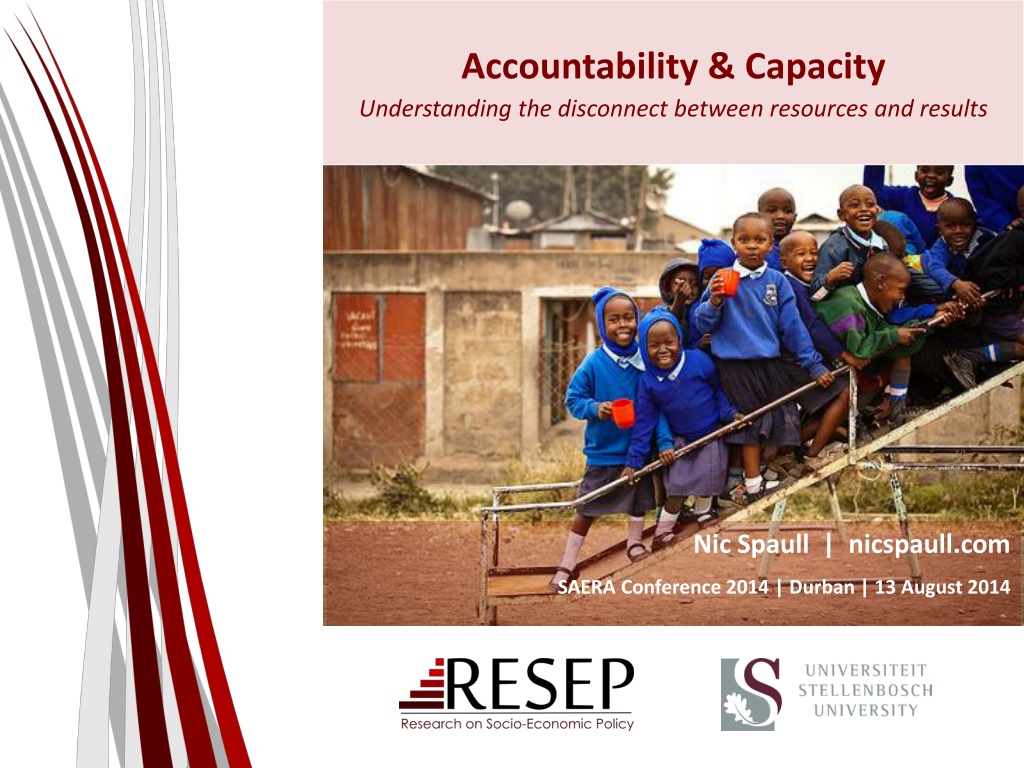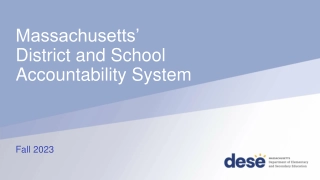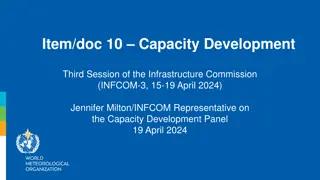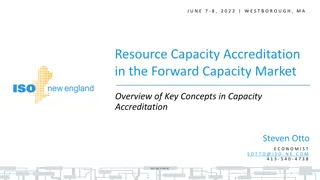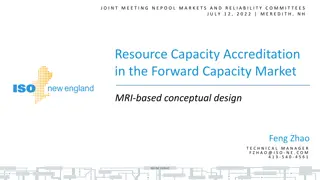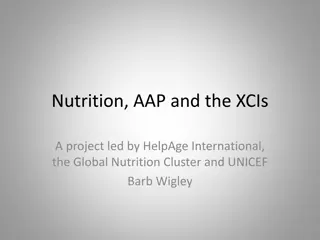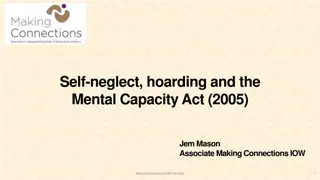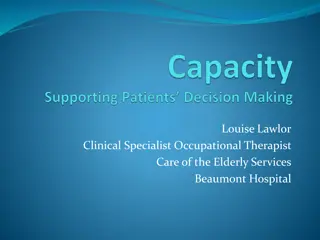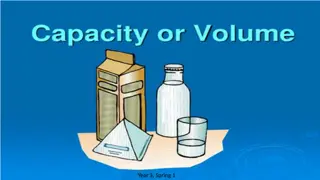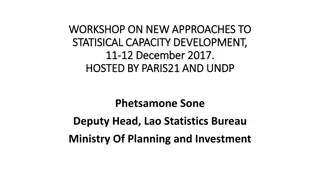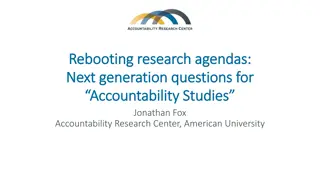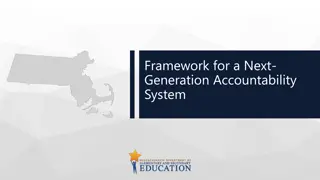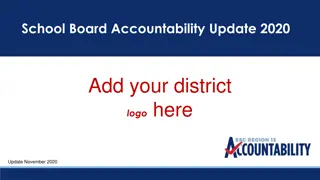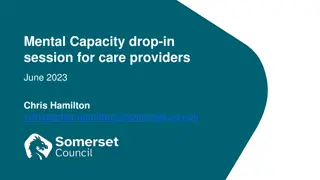Understanding the Disconnect: Accountability and Capacity in Education
This content delves into the critical topic of accountability and capacity in education, exploring the impact of resources on results. It highlights the nuances between spending, resources, and outcomes in the South African education context, emphasizing the intricate relationship between accountability and capacity for effective educational outcomes.
Download Presentation

Please find below an Image/Link to download the presentation.
The content on the website is provided AS IS for your information and personal use only. It may not be sold, licensed, or shared on other websites without obtaining consent from the author. Download presentation by click this link. If you encounter any issues during the download, it is possible that the publisher has removed the file from their server.
E N D
Presentation Transcript
Accountability & Capacity Understanding the disconnect between resources and results Nic Spaull | nicspaull.com SAERA Conference 2014 | Durban | 13 August 2014
Outline 1. Brief overview of spending in SA & some important distinctions 2. Highlights from the literature 3. Capacity without accountability; accountability without capacity 4. False dichotomy between can t and won t 5. The multiple levels of accountability and capacity 6. Capacity without accountability 7. Way forward 2
Not all schools are born equal ? Pretoria Boys High School SA public schools? Different resources (Capacity) Different pressures (Accountability) 3
Expenditure on education 2010/11 Total government expenditure (31% GDP in 2010/11 R733.5bn) Government exp on education (19.5% of Gov exp: R143.1bn) 17% 5% Other Government spending Education: Other current 80.50% 19.50% Education: Capital 78% Education: Personnel A focus on teachers seems warranted both from a budgetary perspective and from the educational literature 4
Important distinctions Increased allocation of resources Increased resources on-the- ground Improved student outcomes Often these 3 are spoken about interchangeably 5
Important distinctions Increased allocation of resources Increased resources on-the- ground Improved student outcomes 6
Important distinctions Increased allocation of resources Increased resources on-the- ground Improved student outcomes 7
Important distinctions Increased allocation of resources Increased resources on-the- ground Improved student outcomes 8
Accountability without capacity Accountability systems and incentive structures, no matter how well designed, are only as effective as the capacity of the organization to respond. The purpose of an accountability system is to focus the resources and capacities of an organization towards a particular end. Accountability systems can t mobilize resources that schools don t have...the capacity to improve precedes and shapes schools responses to the external demands of accountability systems (Elmore, 2004b, p. 117). If policy-makers rely on incentives for improving either a school or a student, then the question arises, incentives to do what? What exactly should educators in failing schools do tomorrow - that they do not do today - to produce more learning? What should a failing student do tomorrow that he or she is not doing today? (Loveless, 2005, pp. 16, 26). People who are being asked to do things they don t know how to do, and being rewarded and punished on the basis of what they don t know, rather than what they are learning, become skilled at subverting the purposes and authority of the systems in which they work. Bad policies produce bad behaviour. Bad behaviour produces value for no one (Elmore, 2004a, p. 22). 10
Capacity without accountability In the absence of accountability sub-systems, support measures are very much a hit and miss affair. Accountability measures provide motivation for and direction to support measures, by identifying capacity shortcomings, establishing outcome targets, and setting in place incentives and sanctions which motivate and constrain teachers and managers throughout the system to apply the lessons learned on training courses in their daily work practices. Without these, support measures are like trying to push a piece of string: with the best will in the world, it has nowhere to go. Conversely, the performance gains achieved by accountability measures, however efficiently implemented, will reach a ceiling when the lack of leadership and technical skills on the part of managers, and curricular knowledge on the part of teachers, places a limit on improved performance. Thus, the third step in improving the quality of schooling is to provide targeted training programs to managers and teachers. To achieve optimal effects, these will need to connect up with and be steered by accountability measures (Taylor, 2002, p. 17). 11
Good description of human behaviour The traditions of school effectiveness research and the economics of education bring complementary perspectives to bear. While the former assumes that individual actors, and in particular school principals and teachers, are motivated by altruism and the desire to do the best for the learners in their care, economists assume that actors are motivated largely by self-interest. Taken together, these views sound like a good description of human behaviour (Taylor, Van der Berg & Mabogoane, 2013: 24) 12
Only when schools have both the incentive to respond to an accountability system as well as the capacity to do so will there be an improvement in student outcomes. (p22) 19
False dichotomies The 2013 NEEDU report makes a useful distinction between teachers who can t and teachers who won t teach which map quite easily onto the capacity and accountability spectra. Why are schools not doing what we expect of them? Is it because they won t or because they can t? The implications for school improvement are very different, dependent on how this question is answered. (NEEDU, 2013: 20) However we have no reason to think that it has to be one OR the other, it could be both or (more likely) some combination of the two. Can t Won t Lack of content knowledge Lack of pedagogical skill Lack of language proficiency Lack of motivation Lack of discipline Lack of accountability/consequences 20
Capacity & Accountability at all levels The capacity & accountability discussion are applicable at all levels of the system and usually the problems are compounded due to multiple capacity/accountability problems at each level. For simplicity sake let s assume that the 3 levels are: 1. Classroom Teachers 2. School Principal / SMT / SGB 3. District/province Subject-advisors, bureaucrats etc.. 21
Teachers CAPACITY Teachers ACCOUNTABILITY TEACHERS Can Can t Will Won t BOTH low capacity AND low accountability Low capacity a b c d School capacity Sufficient capacity NA e g h Low accountabi lity i j k l SCHOOL Accountab ility Sufficient accountabi lity NA m n o SCHOOL X BOTH low capacity AND low accountability 22
Teachers CAPACITY Teachers ACCOUNTABILITY TEACHERS Can Can t Will Won t BOTH low capacity AND low accountability Low capacity a b c d School capacity Sufficient capacity NA e g h Low accountabi lity i j k l SCHOOL Accountab ility Sufficient accountabi lity NA m n o SCHOOL X BOTH low capacity AND low accountability 23
Teachers CAPACITY Teachers ACCOUNTABILITY TEACHERS Can Can t Will Won t BOTH low capacity AND low accountability Even if teachers and schools are completely willing and motivated, if they are situated in a broader system (district/province) that lacks capacity and/or accountability, their potential for improvement is constrained. Low capacity District/ province lacks capacity a b c d School capacity Sufficien t capacity e f g h Low accounta bility i j k l SCHOOL Account ability Sufficien t accounta bility m n o p SCHOOL X BOTH low capacity AND low accountability Teachers CAPACITY Teachers ACCOUNTABILITY TEACHERS Can Can t Will Won t BOTH low capacity AND low accountability District/ province lacks accountability Low capacity a b c d Currently districts and provinces lack the capacity to either increase accountability or to improve capacity due to their own low levels of capacity and accountability School capacity Sufficien t capacity e f g h Low accounta bility i j k l SCHOOL Account ability Sufficien t accounta bility m n o p SCHOOL X BOTH low capacity AND low accountability Teachers CAPACITY Teachers ACCOUNTABILITY 1. Classroom Teachers School Principal / SMT / SGB District/province Subject-advisors, bureaucrats etc.. District/ province lacks BOTH capacity and Accountability TEACHERS Can Can t Will Won t BOTH low capacity AND low accountability Low capacity a b c d 2. School capacity Sufficien t capacity e f g h Low accounta bility i j k l SCHOOL Account ability 3. Sufficien t accounta bility m n o p 24 X SCHOOL BOTH low capacity AND low accountability
Cant / Wont / Constrained / ALL 3? Relationship between learner and teacher test scores in SACMEQ 2007 Thanks to Martin Gustafsson for sharing the graph and analysis This suggests that South Africa s (SOU) weakest teachers, in terms of subject knowledge, not only produce the poorest learner results within the country (as one would expect) but also that the learner results they produce are poorer than those produced by equivalently knowledge-disadvantaged teachers in other countries. For instance, if one compares teachers in South Africa and Swaziland scoring between 600 and 700 in the teacher test, Swaziland s teacher s produce learner results that are 100 points higher than those produced by equivalent South African teachers Source: SACMEQ III dataset (2007). Note: Teachers were grouped according to their test scores for the purposes of this graph. For instance, teachers with scores from 700 and less than 800 are pegged at the 750 level on the horizontal axis, those with scores from 800 and less than 900 are pegged at the 850 level, and so on. The area of the circles is in proportion to the percentage of learners in the country taught by these teachers. 25
Conclusion 1. Accountability without capacity (and vice versa) is problematic and unlikely to lead to the types of outcomes we want. We need BOTH accountability AND capacity 2. The can t and won t distinction is a helpful one but it is NOT an either / or categorization that is a false dichotomy - it can be both. 3. There are multiple levels on which we can see the capacity and/or accountability deficits teachers, schools, districts/provinces 4. Interventions that focus on ONLY capacity OR accountability are likely to be undermined by the lack in the other (accountability or capacity) and thus we need both! 26
Some questions to think about: In the South African education system, 1. What are the capacity-building opportunities available to teachers? 2. Does a (rural) teacher have access to meaningful learning opportunities (ala Shalem ,2003)? (have they been evaluated and shown to work? No) 3. What consequences (if any) revert in the event of non-performance? 4. How can ANA be used for accountability? What are the prerequisites BEFORE ANA can or should be used for feedback or accountability purposes? 27
Thank you www.nicspaull.com/research nicholasspaull@gmail.com @NicSpaull
The left hand barrel has horizontal wooden slabs, while the right hand side barrel has vertical slabs. The volume in the first barrel depends on the sum of the width of all slabs. Increasing the width of any slab will increase the volume of the barrel. So a strategy on improving anything you can, when you can, while you can, would be effective. The volume in the second barrel is determined by the length of the shortest slab. Two implications of the second barrel are that the impact of a change in a slab on the volume of the barrel depends on whether it is the binding constraint or not. If not, the impact is zero. If it is the binding constraint, the impact will depend on the distance between the shortest slab and the next shortest slab (Hausmann, Klinger, & Wagner, 2008, p. 17). 33
Labour Market Type University/ FET High productivity jobs and incomes (17%) Mainly professional, managerial & skilled jobs Requires graduates, good quality matric or good vocational skills Historically mainly white High quality secondary school High SES background +ECD Type of institution (FET or University) Quality of institution Type of qualification (diploma, degree etc.) Field of study (Engineering, Arts etc.) 17% High quality primary school Minority (20%) Unequal society Some motivated, lucky or talented students make the transition - Big demand for good schools despite fees Some scholarships/bursaries Majority (80%) Vocational training Affirmative action - Quality Semi- Skilled (31%) Low quality secondary school Low productivity jobs & incomes Often manual or low skill jobs Limited or low quality education Minimum wage can exceed productivity Low SES background Unskilled (19%) Low quality primary school Unemployed Attainment (Broad - 33%) 34 cf. Servaas van der Berg QLFS 2011
Accountability: teacher absenteeism Teacher absenteeism is regularly found to be an issue in many studies 2007: SACMEQ III conducted 20 days average in 2007 2008: Khulisa Consortium audit HSRC (2010) estimates that 20-24 days of regular instructional time were lost due to leave in 2008 2010: An estimated 20 teaching days per teacher were lost during the 2010 teachers strike (DBE, 2011: 18) Importantly this does not include time lost where teachers were at school but not teaching scheduled lessons A recent study observing 58 schools in the North West concluded that Teachers did not teach 60% of the lessos they were scheduled to teach in North West (Carnoy & Chisholm et al, 2012) 35
Accountability: teacher absenteeism (SACMEQ III 2007 996 teachers) KwaZulu-Natal Limpopo Eastern Cape Western Cape % absent > 1 week striking 81% 97% 32% 82% % absent > 1 month(20 days) 62% 48% 22% 73% % absent > 2 months(40 days) 0% 12% 10% 5% 1.3 days a week 36
When faced with an exceedingly low and unequal quality of education do we . A) Increase accountability {US model} Create a fool-proof highly specified, sequenced curriculum (CAPS/workbooks) Measure learning better and more frequently (ANA) Increase choice/information in a variety of ways B) Improve the quality of teachers {Finnish model} Attract better candidates into teaching degrees draw candidates from the top (rather than the bottom) of the matric distribution Increase the competence of existing teachers (Capacitation) Long term endeavor which requires sustained, committed, strategic, thoughtful leadership (something we don t have) C) All of the above {Utopian model} Perhaps A while we set out on the costly and difficult journey of B?? 37
